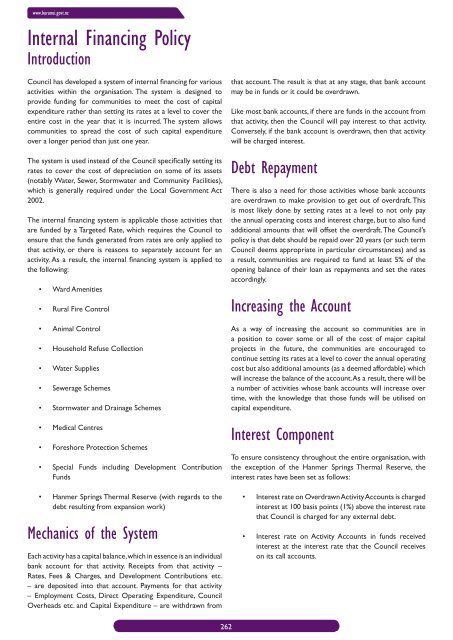Long Term Community Plan 2012-2022 - Hurunui District Council
Long Term Community Plan 2012-2022 - Hurunui District Council
Long Term Community Plan 2012-2022 - Hurunui District Council
Create successful ePaper yourself
Turn your PDF publications into a flip-book with our unique Google optimized e-Paper software.
www.hurunui.govt.nz<br />
Internal Financing Policy<br />
Introduction<br />
<strong>Council</strong> has developed a system of internal financing for various<br />
activities within the organisation. The system is designed to<br />
provide funding for communities to meet the cost of capital<br />
expenditure rather than setting its rates at a level to cover the<br />
entire cost in the year that it is incurred. The system allows<br />
communities to spread the cost of such capital expenditure<br />
over a longer period than just one year.<br />
The system is used instead of the <strong>Council</strong> specifically setting its<br />
rates to cover the cost of depreciation on some of its assets<br />
(notably Water, Sewer, Stormwater and <strong>Community</strong> Facilities),<br />
which is generally required under the Local Government Act<br />
2002.<br />
The internal financing system is applicable those activities that<br />
are funded by a Targeted Rate, which requires the <strong>Council</strong> to<br />
ensure that the funds generated from rates are only applied to<br />
that activity, or there is reasons to separately account for an<br />
activity. As a result, the internal financing system is applied to<br />
the following:<br />
• Ward Amenities<br />
• Rural Fire Control<br />
• Animal Control<br />
• Household Refuse Collection<br />
• Water Supplies<br />
• Sewerage Schemes<br />
• Stormwater and Drainage Schemes<br />
• Medical Centres<br />
• Foreshore Protection Schemes<br />
• Special Funds including Development Contribution<br />
Funds<br />
• Hanmer Springs Thermal Reserve (with regards to the<br />
debt resulting from expansion work)<br />
Mechanics of the System<br />
Each activity has a capital balance, which in essence is an individual<br />
bank account for that activity. Receipts from that activity –<br />
Rates, Fees & Charges, and Development Contributions etc.<br />
– are deposited into that account. Payments for that activity<br />
– Employment Costs, Direct Operating Expenditure, <strong>Council</strong><br />
Overheads etc. and Capital Expenditure – are withdrawn from<br />
that account. The result is that at any stage, that bank account<br />
may be in funds or it could be overdrawn.<br />
Like most bank accounts, if there are funds in the account from<br />
that activity, then the <strong>Council</strong> will pay interest to that activity.<br />
Conversely, if the bank account is overdrawn, then that activity<br />
will be charged interest.<br />
Debt Repayment<br />
There is also a need for those activities whose bank accounts<br />
are overdrawn to make provision to get out of overdraft. This<br />
is most likely done by setting rates at a level to not only pay<br />
the annual operating costs and interest charge, but to also fund<br />
additional amounts that will offset the overdraft. The <strong>Council</strong>’s<br />
policy is that debt should be repaid over 20 years (or such term<br />
<strong>Council</strong> deems appropriate in particular circumstances) and as<br />
a result, communities are required to fund at least 5% of the<br />
opening balance of their loan as repayments and set the rates<br />
accordingly.<br />
Increasing the Account<br />
As a way of increasing the account so communities are in<br />
a position to cover some or all of the cost of major capital<br />
projects in the future, the communities are encouraged to<br />
continue setting its rates at a level to cover the annual operating<br />
cost but also additional amounts (as a deemed affordable) which<br />
will increase the balance of the account. As a result, there will be<br />
a number of activities whose bank accounts will increase over<br />
time, with the knowledge that those funds will be utilised on<br />
capital expenditure.<br />
Interest Component<br />
To ensure consistency throughout the entire organisation, with<br />
the exception of the Hanmer Springs Thermal Reserve, the<br />
interest rates have been set as follows:<br />
• Interest rate on Overdrawn Activity Accounts is charged<br />
interest at 100 basis points (1%) above the interest rate<br />
that <strong>Council</strong> is charged for any external debt.<br />
• Interest rate on Activity Accounts in funds received<br />
interest at the interest rate that the <strong>Council</strong> receives<br />
on its call accounts.<br />
262

















